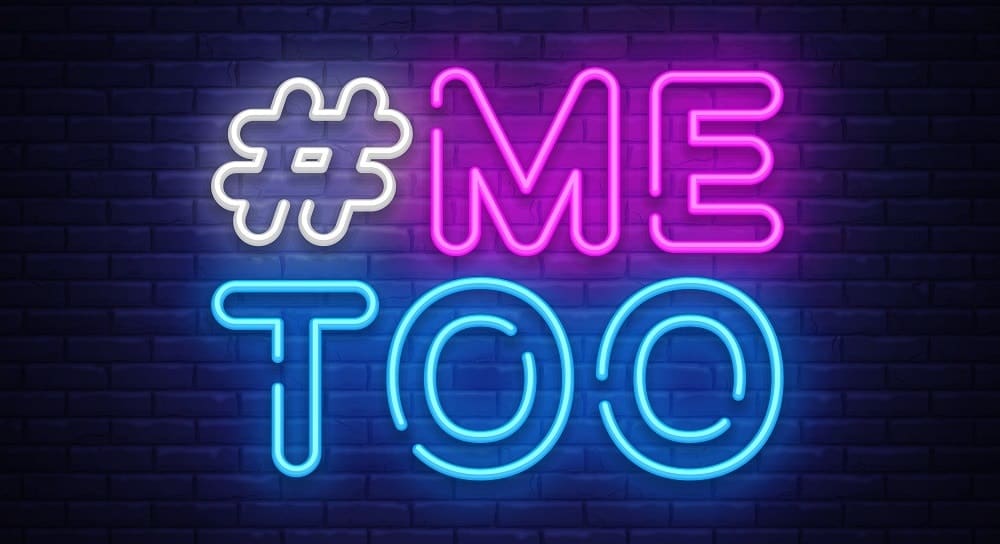Lawrence & Bundy’s Allegra Lawrence-Hardy and Kathy Glennon explore how the #MeToo movement has impacted the legal landscape and the workplace in the last two years, discuss red flags for employers and offer tips on mitigating risk.
The #MeToo movement began in 2017 in response to the exposure of sexual harassment and assault in the entertainment industry. Since then, it has grown into a social phenomenon. We are only now just beginning to see the long-lasting effects the movement will have on the workplace. Conscientious employers must understand the roots of the #MeToo movement and the long-standing concerns it addresses to respond effectively to employees’ increased demands for better responsiveness and timeliness in investigating claims of sexual harassment.
Do We Find Ourselves in an Era Beyond Title VII’s Reach?
As a result of the popularity of #MeToo, victims have shown a preference for instantaneous justice through social media rather than a protracted legal battle in court. Employers can no longer be fully comfortable relying on Title VII either. A win at the summary judgment stage takes years and can result in exorbitant attorneys’ fees. Also, since individual harassers cannot be sued directly, employers are forced to defend the behavior without receiving the deterrence benefit that would result from personal liability. In addition, the severe or pervasive standard has simply not kept pace with what is currently happening in the workplace. Employees are becoming more empowered due to the unifying nature of #MeToo and are demanding attention. While harassment policies used to track the language of Title VII case law closely, the current trend is to broaden those policies to reflect a more common-sense approach to unacceptable behavior that reflects the collective moral outrage. A recent survey by a Chicago consulting firm discovered that eight months after #MeToo began, 52 percent of companies surveyed responded that they were reviewing their sexual harassment policies and of those companies, 58 percent had updated them.[1] By using policy revisions to make it easier to respond to harassment and harassers internally, employers are self-policing in an attempt to avoid not only a costly Title VII battle in court, but also reputation-harming social media posts.
How Did We Get Here?
Employees Have Expressed Frustration with the Legal Process
The Women in the Workplace study by McKinsey & Company and Lean In (“the Lean In study”) shows that 68 percent of the women surveyed felt that “disrespectful behavior toward women” is not addressed promptly.[2] Further, 30 percent of the women were not confident that a complaint would lead to a full and fair outcome – twice the percentage of men who felt the same.[3] These women have moved to social media as a faster method to the result they seek.
The Internet Provides Open Communication with No Gatekeepers
Fed up with the obstacles to traditional methods of complaining, women who had been victimized began to feel validated and energized when the Weinstein scandal broke and his victims spoke out to the media. During that time, actress Alyssa Milano invoked the power of the #MeToo movement, started by Tarana Burke in 2006, by sending a Tweet suggesting that victims of sexual harassment or assault post the words “me too” to show their solidarity.[4] Within 24 hours, there were over 600,000 posts that included the tag #MeToo.[5]
With this newly found courage, women began recounting their victimization in detail online, often identifying the individuals they were accusing. These digital accusations required no confirmation of validity before posting and frequently detailed encounters that purported to occur decades prior.
Formal Complaints Rise
The EEOC witnessed firsthand the change in women’s attitudes about reporting harassment. In fiscal year 2018 (“FY 2018”), the agency reported twice as many visits to its sexual harassment webpage as the prior year.[6] Accordingly, the number of sexual harassment charges filed rose by 13.6 percent in FY 2018, with a 23.6 percent increase in reasonable cause findings.[7] Through litigation and charges, the EEOC assisted sexual harassment victims in recovering almost $70 million in FY 2018.[8]
Alleged Attackers Fight Back
As a result of victims opening up online about their experiences, those alleged to have engaged in misbehavior suffered reputational and career harm. Many of the accused have fought back, filing or threatening to file defamation lawsuits to clear their names.[9] This litigation can have a chilling effect on victims who have spoken out, since defending against one lawsuit can cost tens of thousands of dollars, involve revisiting the details of their victimization and potentially facing their harasser/abuser in court.[10]
State Legislatures Take Action
State lawmakers have taken notice of the #MeToo movement and introduced legislation on several topics aimed at making it easier for victims to tell their stories.
Employers have historically used nondisclosure provisions in employment agreements and settlement agreements to keep details of alleged sexual harassment confidential. The prevailing sentiment in the wake of #MeToo is that these agreements allow employers to conceal misconduct and avoid addressing it. At least 17 states have considered bills to prohibit nondisclosure agreements in the sexual harassment context.[11] Four of those bills failed,[12] but the others were signed into law or are under consideration.
Another target for state laws has been forced arbitration agreements in the sexual harassment or abuse context since statistics show these agreements tend to suppress victims’ claims. In fact, more than half of American workers are subject to an arbitration clause, but only a few thousand of those employees file claims each year. [13] Since the success rate for employees in arbitration is much lower than in court, as are the damages, many victims have trouble even finding an attorney to represent them.[14] At least six states have prohibited or are considering prohibiting forced arbitration in the sexual harassment context, while one state’s efforts stalled.[15] These new laws are not expected to have much effect, however, as they will likely be blocked by the Federal Arbitration Act (FAA), which preempts state law “prohibit[ing] outright the arbitration of a particular type of claim.”[16]
Finally, state legislatures have addressed #MeToo concerns in several other ways as well: requiring mandatory sexual harassment training,[17] updating previous harassment training requirements, mandating sexual harassment policies with minimum requirements, requiring posting of sexual harassment policies and dissemination to employees, increasing the statute of limitations for sexual harassment claims and requiring annual disclosures of sexual harassment claim statistics to state departments of human rights. [18]
Congress Takes Action
Likewise, federal lawmakers have also introduced legislation designed to address issues raised by #MeToo. The Ending Forced Arbitration of Sexual Harassment Act of 2017 (S. 2203) attempted to outlaw predispute arbitration agreements for allegations of sex discrimination, actionable under Title VII.[19] The bill did not advance beyond committee review.
In February 2019, the EMPOWER Act (S. 575) was introduced in the Senate to “deter, prevent, reduce and respond to harassment in the workplace, including sexual harassment…” [20] The bill prohibits employers from requiring nondisclosure and nondisparagement agreements as a condition of employment. A similar bill is being considered in the House of Representatives (H.R. 1521).[21] Both measures are in committee review.
In May 2019, the House introduced the Restoring Justice for Workers Act (H.R. 2749) which seeks to “prohibit predispute arbitration agreements that require arbitration of work disputes.”[22] The bill is in committee review.
Companies Concede to Pressure
The #MeToo movement has encouraged many large companies to drop forced arbitration for sexual harassment claims. Google made the decision in response to a walkout by 20,000 employees in November 2018, followed by Facebook, Airbnb and eBay.[23] Microsoft dropped the practice in December 2017, followed by Uber and Lyft in mid-2018.[24] Moving these disputes back to the courtroom will allow judges to think through the case law and determine if the law needs to evolve to keep pace with the current workplace landscape.[25]
Courts Stay the Course So Far (with one exception)
While plenty has happened in the almost two years since the beginning of #MeToo, there has not been enough time to see much evidence of a direct impact on sexual harassment case law. One notable exception is Minarsky v. Susquehanna County, 895 F.3d 303 (3rd Cir. 2018). In Minarsky, the Third Circuit considered a Faragher-Ellerth affirmative defense in denying defendant’s motion for summary judgment.[26] In an extensive footnote, the court discussed the significance of the #MeToo stories being shared in the media and acknowledged that “a jury could conclude that [an] employee’s nonreporting was understandable, perhaps even reasonable.”[27] The court found that “[i]f a plaintiff’s genuinely held, subjective belief of potential retaliation from reporting her harassment appears to be well-founded and a jury could find that this belief is objectively reasonable … the court should leave the issue for the jury to determine at trial.”[28] The court distinguished the case from one where a plaintiff fears retaliation in a general sense, with no specific evidence to support the claim, noting that Minarsky provided evidence that “asserting herself” resulted in more hostile conditions.[29] Time will tell if other Circuits follow the Third Circuit’s lead.
Red Flags for Employers
Lessons Ripped From the Media
Harvey Weinstein: After Weinstein settled with an accuser for $1 million in 2015, rather than fire him, The Weinstein Company renegotiated his contract, requiring that he reimburse the company for costs and expenses associated with any “payment to satisfy a claim that [he had] treated someone improperly in violation of the company’s code of conduct” and that he pay liquidated damages for all payments made on his behalf. [30] By continuing to employ Weinstein despite his total disregard for the company’s conduct policy, The Weinstein Company opened itself up to liability that resulted in bankruptcy and a $45 million settlement with alleged victims.
Fox News: The network stood behind anchor Bill O’Reilly for years, despite his spending $45 million to settle at least six claims of sexual harassment. [31] Fox even re-signed O’Reilly to a four-year contract, paying $25 million per year, shortly after he settled a claim for $32 million with a Fox news analyst.[32] Once news of the settlements broke in the media, Fox cut ties with him but paid him $25 million for his exit.[33] Likewise, the network paid $40 million for CEO Roger Ailes’ exit after paying multiple harassment settlements on his behalf, including one $20 million payment. [34]
Matt Lauer: NBC protected “Today” show co-host Matt Lauer for years due to his high profile at the network. He was ultimately fired in November 2017 for “inappropriate sexual behavior,” and it was widely reported that Lauer had a button installed on his desk that would automatically lock his office door remotely, so he could avoid anyone witnessing his misconduct. [35] Whether the button was installed by someone with NBC or someone hired by Lauer, it was certainly a talking point among at least the “Today” show staff. The fact that no one complained (or complaints were not taken seriously) demonstrates that the show and the network created a workplace culture that somehow accepted this behavior. Employers can easily avoid NBC’s mistakes by staying attuned to employee attitudes and working diligently to provide an atmosphere where everyone feels heard.
Women’s Underrepresentation in the Workplace and in Leadership Roles Continues
Women still represent a minority of employees in many companies, from entry-level positions to the C-Suite.[36] The Lean In study found that since 2015, women have made no appreciable gains in representation in the 279 companies and among the 64,000 employees studied.[37] For positions in the C-Suite, only one in five is a white female, while only one in 25 is a woman of color.[38] Notably, the study dispelled the notion that this under-representation results from attrition, instead attributing the disparities to performance bias in hiring and promotion, lack of support from managers and lack of access to senior leaders.[39] If the current trend continues, the study found that in 10 years, the number of women in senior positions will increase only 1 percentage point.[40] In fact, the Lean In study showed that commitment to gender diversity in companies is declining, with 90 percent of companies citing it as a priority in 2017, as opposed to 84 percent of companies in 2018.
When the majority of individuals in power are men, and often only one woman is present in any given senior-level meeting, conditions can be ripe for sexual-based harassment. In the Lean In study, 55 percent of women in senior leadership roles reported experiencing sexual harassment during their career.[41] The study also found that harassment is twice as likely to happen to women who are the sole female representative in the room.[42] Contributing to this is a boys club approach to harassment, which shames men who do not participate and makes them feel as if their careers are in jeopardy if they speak up in defiance.[43] Less than one-third of employees in the study said their managers “often challenge biased language and behavior” when they witness it.[44] This lack of female representation in senior management roles, and the resulting behavior, needs to be addressed before women can feel confident that senior leadership will be truly receptive to their concerns.
Shutting Out Women is Not the Answer
For men fearing an unsubstantiated harassment claim in the wake of #MeToo, the solution seems simple: avoid interacting with women in the workplace altogether. This approach is not only a wildly impractical notion, it is obviously illegal. By shutting women out of one-on-one meetings with men or refusing to invite them to critical networking or client events (in the workplace or outside of the workplace), men further victimize females by denying them important opportunities and expose the employer to a gender discrimination claim.[45] For example, on Wall Street, where women are not widely represented in senior ranks, female employees require the support of male mentors to help them advance.[46] This mentoring cannot be effective if the male superior is afraid to meet with the woman alone.[47] As a result, this ostracizing of women can have detrimental effects on women’s careers and further contribute to a boys club atmosphere that can promote harassment.[48]
Hiring Concerns for Candidates with a #MeToo History
A lingering question for many companies is whether they can hire someone previously accused in a #MeToo post. If the individual has pending civil or criminal cases involving the alleged behavior, the answer is a clear no. If the accused denies the accusations and the former employer will not comment on the investigation, however, it may be impossible to know the truth.
Employers need to examine the details in the accusation and assume for argument’s sake they are true and that the individual will be a repeat offender. When that happens, can the organization defend itself in the court of public opinion? Will the explanation make sense to an outsider? What effect will the coverage have on the employer’s reputation in the marketplace? Would the employer be able to defend against allegations of negligence in hiring and retention? Were any steps taken to discourage repeat behavior?
While every situation is different, the bottom line is that employee safety is paramount. If a hiring decision has the chance to result in the victimization of any employee, employers would do well to move on to the next candidate.
Moving Forward After #MeToo
Complaints and Investigations are Now Very Serious Business
While the legal standards defining sexual harassment remain the same, newly empowered employees now expect more from their employer’s investigations of wrongdoing than they did before. If employees feel they are not being taken seriously, they now feel comfortable taking their concerns to social media. Widely broadcast allegations, regardless of their veracity, can seriously damage an employer’s reputation, especially if the claims suggest a history of inadequate responses to accusations.
Proactive employers would do well to assure employees they will resolve concerns quickly and completely to avoid employees resorting to external complaint mechanisms. Such an approach results in the best outcomes for both employer and employee. The employer can avoid reputational damage from an online accusation or a multiyear battle in court for a summary judgment decision. Likewise, the employee gets the satisfaction of knowing that the organization is truly concerned about his/her well-being and that the work environment will be restored to normal.
There are several considerations for employers reassessing their processes to ensure employees will have faith in the compliance system:
- Provide multiple avenues of complaint, including a hotline, so employees can find someone they feel comfortable approaching with concerns.
- Train any potential recipient of a complaint (supervisors, managers, human resources, legal, hotline personnel) on how to appropriately respond and the internal resources to be notified every time. Emphasize the importance of reporting all concerns received and relying on the investigation team to determine the truthfulness and/or severity of the claims.
- Train first-line supervisors to report to human resources any interactions they witness that may need corrective action, without waiting for an employee to complain.[49] Discuss examples of behavior that can later turn problematic or even criminal so supervisors can identify threats early. The goal is to counsel problem employees out of the organization before they can cause harm to anyone.
- Train HR and legal on how to investigate concerns completely and promptly, keeping the complainant informed at all times.
- Highlight the similarities and differences between legally defined sexual harassment and harassment that violates internal policies.
- Emphasize avoiding any possible hint of retaliation.
- Focus on efficiency so the accuser does not lose patience and turn to social media.
- Encourage early and frequent consultation with outside counsel during the investigation.
- Act swiftly to discipline or fire harassers when there are clear policy violations. Hesitating sends the wrong message to employees; accusers feel as if they have not been heard and harassers may become emboldened. Decisive action makes clear to all employees that there is zero tolerance for harassment of any kind.
- Train HR and legal on changes to state or local law that might affect settlement or employment agreements.
- Consider adding language to employment contracts to discourage misconduct. For example, defining “cause” to include harassment would prevent payment of severance or vesting of stock upon termination for misconduct and also sends a clear message up front about the organization’s commitment to its harassment policy.[50]
- Confirm that the harassment, discrimination and code of conduct policies are clear and provide straightforward examples of misconduct.
- Conduct a yearly in-person training session on harassment and discrimination and ask employees to reaffirm in writing their understanding of all policies on employee conduct.
- Ask a respected member of management to conduct the training to increase employee interest.
- Add discussions of detailed ideas on how to create a more inclusive environment for all.
- Use employee roundtables to discuss harassment and role-play uncomfortable situations.[51]
- Include guidance to encourage bystanders who witness sexual harassment to get involved.
- Monitor social media for complaints about the organization and take necessary steps to address concerns.
- Complete annual reviews of complaint and response data and respond promptly to troubling trends.
Ignore Workplace Culture Issues at Your Own Peril
#MeToo provides the perfect opportunity for employers to open up communication with employees about the organization’s culture overall and within each location and department to determine areas for improvement. These discussions can assist with identifying concerns before they grow into major problems:
- Consider using an anonymous survey to identify issues in the workforce and quickly resolve them.[52] This feedback will also indicate whether employees have faith in the internal system or whether they are likely to turn to social media when they have problems.
- Analyze the male-to-female ratio, especially in leadership positions. Are most of the leadership positions held by men with unimpeded power?[53] If so, consider whether there is a higher risk that misconduct will occur and determine how best to mitigate that risk.
- Review statistics on hiring and promotions annually to determine if adequate opportunities are being provided to women and minorities.
- If female and/or minority representation is low, is there a succession plan to increase those numbers? Consider requiring each senior leader to include a woman and a person of color as a potential successor so those candidates will receive the necessary experience and support for future promotion.[54]
- For senior leaders’ performance metrics, consider requiring proven progress in gender and minority diversity.
- Provide training for management on how to support the progression of women and minorities, including increasing face time and acting as an ally in group settings.[55]
Conclusion
The post-#MeToo era is replete with uncertainty, but for thoughtful employers, the call to action provides a perfect opportunity to improve and enhance workplace culture and move forward in a way that includes and protects all employees.
[1] Hannah Hayes, Is Time Really Up for Sexual Harassment in the Workplace? Companies and Law Firms Respond, A.B.A., (Jan. 17, 2019).
[2] Rachel Thomas, Lareina Yee, Marianne Cooper, Alexis Krivkovich, Ellen Konar, Irina Starikova, Megan Rooney, Kelsey Robinson, Mary Noble-Tolla, Marie-Claude Nadeau, Ali Bohrer, & Nicole Robinson, Women in the Workplace 2018, McKinsey & Company and Lean In, (last visited August 30, 2019) at p. 18.
[3] Id.at p. 19.
[4] Heidi Stevens, #MeToo campaign proves scope of sexual harassment, flaw in Mayim Bialik’s op-ed, 1, Chicago Tribune, (Oct. 16, 2017, 11:15 AM). Milano credited Tarana Burke with the original use of “me too” in this context. Id.
[5] Riley Griffen, Hannah Recht & Jeff Green, #MeToo: One Year Later, Bloomberg, (Oct. 5, 2018).
[6] What You Should Know: EEOC Leads the Way in Preventing Workplace Harassment, EEOC, 2019.
[7] Id.
[8] Id.
[9] This is not unique to the U.S. – well-known figures in France, India, and Australia have filed defamation lawsuits to address #MeToo accusations. Kara Fox & Antoine Crouin, Men are suing women who accused them of harassment. Will it stop others from speaking out?, CNN, (June 5, 2019, 4:24 PM), .
[10] Alyssa R. Leaer, A “SLAPP” In The Face of Free Speech: Protecting Survivors’ Rights to Speak Up in the “Me Too” Era, 17 First Amend. L. Rev. 441, 448 (Spring 2019).
[11] See Ariz. Rev. Stat. Ann. § 12-720(D)(2019); Cal. Civ. Proc. Code § 1001 (West 2019); Ill. Public Act 101-0221 (2019)(effective Jan. 1, 2020); 2019 CT S.B. 697 (NS) (pending, proposed effective date July 1, 2019);
2019 La. Sess. Law Serv. Act 413 (S.B. 182) (West, effective Jan. 1, 2020) (provides for public reporting of harassment settlement details (without name of victim); applies to state agencies only); 2019 NV A.B. 248 (NS); N.J. Stat. Ann. 10:5-12.8 (West 2019); N.Y. Gen. Oblig. § 5-336 (McKinney 2019); 2019 OR S.B. 726 (NS); Tenn. Code Ann. § 50-1-108 (West 2018); Vt. Stat. Ann. tit. 21 § 495h (West 2018); Va. Code Ann. § 40.1-28.01 (2019) (prohibiting non-disclosure agreements for sexual assault claims); Wash. Rev. Code Ann. § 49.44.210 (West 2018) (prohibiting non-disclosure agreements as a condition of employment, but allowing confidentiality provisions in settlement context); H.B. 3011 W.V. Legis. (Wvo. 2019) (under consideration).
[12] See S.B. 866, 2019 Leg. (Fla. 2019) (postponing discussion of bill prohibiting employers from requiring nondisclosure agreement or waiver related to sexual harassment as a condition of employment); H.B. 2696, 2018 Leg. (Kan. 2018) (ending discussion of proposal to prohibit non-disclosure agreements in sexual harassment or abuse cases); S.B. 0546, 2019 Leg. (R.I. 2019) (holding for further study a bill limiting non-disclosures in sexual harassment cases); H.B. 618 86th Leg. Reg. Sess. (Tex. 2019) (leaving bill pending in committee).
[13] Jean R. Sternlight, Mandatory Arbitration Stymies Progress Towards Justice in Employment Law: Where To, #MeToo?, 54 Har. C.R.-C.L. L. Rev. 155, 179 (Winter 2019).
[14] Id.
[15] Ill. Public Act 101-0221 (2019) (effective Jan. 1, 2020); MD. CODE ANN. LAB. & EMPL. § 3-715 (2018) (prohibits agreements from requiring waiver of rights or remedies related to future sexual harassment claims); N.J. Stat. Ann. 10:5-12.7 (2019); N.Y. C.P.L.R. § 7515 (2019); Vt. Stat. Ann. tit. 21 § 495h (West 2018); Wash. Stat. Code Ann. A ST 49.44.085 (West 2018). But see 2019 HB 618 86th Leg. Reg. Sess. (Tex. 2019) (leaving bill pending in committee).
[16] Kindred Nursing Centers Ltd. Partnership v. Clark, 137 S.Ct. 1421, 1426 (2017) (quoting AT&T Mobility LLC v. Concepcion, 563 U.S. 333, 339 (2011)).
[17] See Cal. Gov’t Code § 12950.1 (West 2019)(updated training requirements); 2019 Conn. Legis. Serv. P.A. 19-16 (S.G.3)(West) (requiring training and disclosure of sexual harassment policy to new employees and imposing penalties on employers for non-compliance); Del. Code Ann. tit. 19, § 711A (2019) (employers with 50 or more employees must provide training every two years); Ill. Public Act 101-0221 (2019)(effective Jan. 1, 2020); La. Stat. Ann. § 42:343 (2019)(requires one hour of training per year for all employees and additional training for employees designated to receive sexual harassment complaints; applies to state agencies only); N.Y. Lab. Law § 201-g (McKinney 2019); VT Stat. Ann. tit. 21 § 495h (West 2018)(encouraging sexual harassment training for all employees).
[18] Conn. Gen. Stat. § 46a-82 (2019) (increasing statute of limitations for discrimination claims to 300 days); Ill. Public Act 101-0221 (2019)(effective Jan. 1, 2020)(requires annual disclosure to Illinois Department of Human Rights of adverse rulings or judgments); 2019 La. Sess. Law Serv. Act 413 (S.B. 182) (West, effective Jan. 1, 2020) (requires policy against sexual harassment; requires reimbursement of settlements by harasser; applies to state agencies only); 2018 MD H.B. 1596 (NS) & 2018 MD S.B. 1010 (NS) (requiring employers with 50 or more employees to complete survey on sexual harassment settlements and submit to Commission on Civil Rights); N.Y. Lab. Law §201-g(1) (McKinney 2019) (mandating sexual harassment policy with minimum requirements); 2019 OR S.B. 726 (NS) (requiring anti-discrimination policy and dissemination to employees; allowing employers to avoid severance obligations for employees who violated anti-discrimination law or policies; increasing statute of limitations for discrimination claims to five years); VT Stat. Ann. tit. 21 § 495h (West 2018)(requiring sexual harassment policy that must be posted and provided to employees).
[19] Ending Forced Arbitration of Sexual Harassment Act of 2017, S. 2203, 115th Cong.
[20] EMPOWER Act-Part 1, S. 575, 116th Cong. (2019).
[21] EMPOWER Act, H.R. 1521, 116th Cong. (2019).
[22] Restoring Justice for Workers Act, H.R. 2749, 116th Cong. (2019).
[23] Jena McGregor, Google and Facebook ended forced arbitration for sexual harassment claims. Why more companies could follow, The Washington Post, (November 12, 2018). Kate Clark, Airbnb ends forced arbitration days after Google, Facebook did the same, TechCrunch, (November 12, 2018).
[24] Id.
[25] Jean R. Sternlight, Mandatory Arbitration Stymies Progress Towards Justice in Employment Law: Where To, #MeToo?, 54 Har. C.R.-C.L. L. Rev. 155, 200 – 201 (Winter 2019).
[26] Minarsky, 895 F.3d at 306.
[27] Id. at 313 n. 12.
[28] Id. at 314.
[29] Id. at 315; See Kastanidis v. Penn. Dept. of Human Services, 2018 WL 3584976, at 10 (M.D.Pa. July 26, 2018) (finding a question of fact as to whether plaintiff failed to complain because she reasonably believed it would be futile). Other Circuits have continued to employ the same pre #MeToo analysis. See Lacasse v. Didlake, Inc., 712 Fed. Appx. 231, 238 (4th Cir. 2018) (finding that plaintiff’s failure to complain to anyone in the “official reporting channel” was sufficient to establish the second prong of the affirmative defense); Hunt v. Wal-Mart Stores, Inc., 931 F.3d 624 (7th Cir. 2019) (holding that plaintiff’s four month delay in reporting harassment was unreasonable).
[30] October 20, 2015 Employment Agreement between Harvey Weinstein and The Weinstein Company Holdings LLC. at ¶ 11i.
[31] Emily Steel & Michael S. Schmidt, Bill O’Reilly Settled New Harassment Claim, Then Fox Renewed His Contract, The New York Times, (Oct. 21, 2017).
[32] Id.
[33] Id.
[34] Michael M. Grynbaum & John Koblin, Fox Settles with Gretchen Carlson over Roger Ailes Sex Harassment Claims, The New York Times, (Sept. 6, 2016).
[35] Paul Farhi, Today show host Matt Lauer fired after claims of ‘inappropriate sexual behavior,’ The Washington Post, Nov. 29, 2017.
[36] Thomas et al., supra note 9, at p. 15.
[37] Id. at p. 5.
[38] Id. at p. 5.
[39] Id. at p.6 – 14.
[40] Id. at p. 7.
[41] Id. at p. 5.
[42] Id. at p. 20.
[43] Williams & Lebsock, supra note 11 at p. 1.
[44] Thomas et al., supra note 9, at p. 39.
[45] Williams & Lebsock, supra note 11 at p. 10.
[46] Gillian Tan and Katia Porzecanski, Wall Street Rule for the #MeToo Era: Avoid Women at All Cost, Bloomberg, (December 3, 2018, 9:59 AM).
[47] Id.
[48] Id.
[49] James Campbell Quick & M. Ann McFadyen, Bad Behavior is Preventable, Harvard Business Review, February 2, 2018.
[50]Jena McGregor, How #MeToo is reshaping employment contracts for executives, The Washington Post, (October 13, 2018), .
[51] Vanessa Fuhrmans, What #MeToo Has to Do With the Workplace Gender Gap, Wall Street Journal, (October 23, 2018, 4:16 AM).
[52] Id.
[53] Campbell & McFadyen, supra note 57.
[54] Fuhrmans, supra note 59.
[55] Id.



 Allegra Lawrence-Hardy is the co-founder of the law firm,
Allegra Lawrence-Hardy is the co-founder of the law firm,  Kathy Glennon specializes in employment litigation and counseling for Lawrence & Bundy LLC. She has represented clients in individual and class action discrimination lawsuits, as well as collective action wage and hour lawsuits. Kathy has experience conducting investigations and counseling employers on matters such as employee discipline, terminations and leaves of absence. She has also reviewed and drafted employee handbooks, policies and employee agreements.
Kathy Glennon specializes in employment litigation and counseling for Lawrence & Bundy LLC. She has represented clients in individual and class action discrimination lawsuits, as well as collective action wage and hour lawsuits. Kathy has experience conducting investigations and counseling employers on matters such as employee discipline, terminations and leaves of absence. She has also reviewed and drafted employee handbooks, policies and employee agreements.








